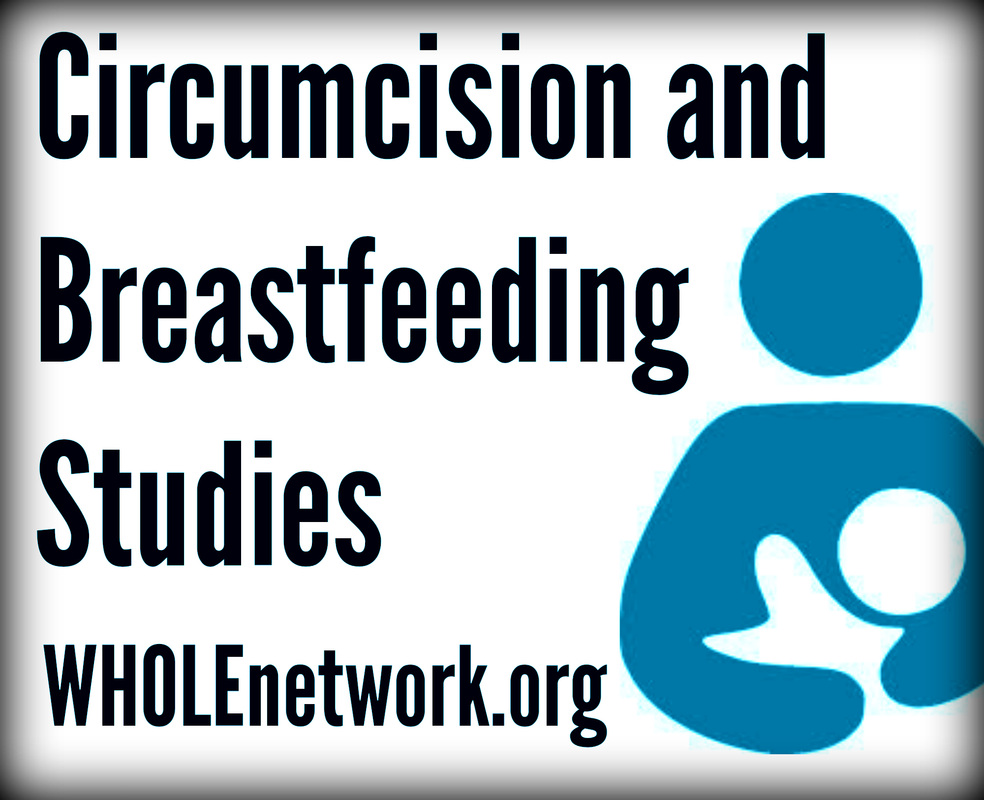
Circumcision and Breastfeeding Studies
Over the years, many studies have established a link between infant circumcision and difficulty breastfeeding. Here is a summary of a dozen related medical studies and literature:
Breastfeeding Answers Made Simple: A Guide for Helping Mothers
The pain of circumcision causes breastfeeding problems in some babies. After this procedure, a baby may have trouble settling in at the breast, may refuse the breast, or may shut down and be unresponsive.
Mohrbacher, Nancy. Breastfeeding Answers Made Simple: A Guide for Helping Mothers. Plano: Hale, 2010.
The Breastfeeding Answer Book
When a baby undergoes a painful medical procedure, such as a heel stick, injection, spinal tap, or circumcision, he may shut down and be unreceptive to feedings until he is feeling better.
Mohrbacher N, Stock J. The Breastfeeding Answer Book. Schaumburg: La Leche League International, 2003.
Breastfeeding Problems After Circumcision
Unquestionably, many babies are circumcised and go on to breastfeed without difficulty. But for some, the pain after circumcision may cause just enough disruption to interfere with the breastfeeding relationship.
[Breastfeeding problems after circumcision]. Leaven, September-October 1994:78.
Circumcision and Breastfeeding
Boys who are circumcised before breastfeeding has been established have more problems with breastfeeding. Conversely, boys who are recovering from a traumatic birth but are left intact have fewer breastfeeding difficulties.
Lee N. Circumcision and Breastfeeding. [Letter] J Hum Lact 2000;16(4):295.
The Case Against Circumcision
The radical practice of routinely circumcising babies did not begin until the Cold War era. This institutionalization of what amounted to compulsory circumcision was part of the same movement that pathologized and medicalized birth and actively discouraged breastfeeding.
Fleiss P. 1997. The case against circumcision. Mothering Magazine Winter 1997:36-45.
Breastfeeding Must Be Given Priority Over Circumcision
Prospective parents should be warned in advance of circumcision’s interference with breastfeeding. While current informed medical opinion does not support the practice, some parents, however, still have their baby circumcised. In this case, the circumcision should be avoided at least until breastfeeding is well established. Such a recommendation should be a part of all printed material regarding breastfeeding that is provided to expectant mothers in advance of delivery and should be volunteered by lactation consultants in every pre-partum counseling session.
Hill G. Breastfeeding must be given priority over circumcision. J Hum Lact 2003;19(1):21.
Acetaminophen Analgesia in Neonatal Circumcision: The Effect on Pain
Preoperatively, all neonates fed well. Neonate feeding behavior after circumcision deteriorated in neonates in both groups. Of those breastfed, 2 of 11 (18%) in the acetaminophen group and 3 of 8 (37%) in the placebo group either were judged to have breast-fed poorly or required formula feedings after circumcision. Of neonates who were formula-fed, 4 of 12 (33%) in the acetaminophen group and 2 of 13 (15%) in the placebo group fed poorly after circumcision. Acetaminophen did not significantly influence feeding changes for either breast-fed or formula-fed neonates.
Howard CR, Howard FM, and Weitzman ML. Acetaminophen analgesia in neonatal circumcision: the effect on pain. Pediatrics 1994;93(4):641-646.
Behavioral Effects of Circumcision With and Without Anesthesia
Changes in heart rate, respiratory rate, transcutaneous pO2, adrenal cortical hormone secretion, sleep patterns, and behavioral patterns have been shown to be altered during and/or following circumcision of the full-term neonate.
Dixon S, Snyder J, Holve R, Bromberger P. Behavioral effects of circumcision with and without anesthesia. J Dev Behav Pediatr 1984; 5(5): 246-50.
Circumcision I: Effects Upon Newborn Behavior
Our results demonstrate than infants change behaviors after circumcision in about 90 percent of cases. Families, nurses, and physicians have appreciated that babies are different after circumcision, but there have not been controlled studies using the NBAS scale to substantiate these changes... We have shown that behavior differences after circumcision in 4/12 (33%) subjects persisted for at least 22 hours.
Marshall RE, Stratton WC, Moore JA, et al. Circumcision I: effects upon newborn behavior. Infant Behavior and Development 1980;3:1-14.
Circumcision II: Effects Upon Mother-Infant Interaction
The effects of circumcision upon mother-infant interaction were examined in an observational study of 59 mother-infant pairs during hospital feedings using a specifically designed mother-infant interaction observation system that examined 43 discreet behaviours relating to feeding, gaze, facial expression, vocalizations and touch. The experimental group was circumcised after the second feeding and the control group after the fourth feeding... Immediately following circumcision there were differences in the feeding patterns between the two groups. The experimental group exhibited fewer intervals of uninterrupted feeding than did the control group.
Marshall RE, Porter FL, Rogers AG, et al. Circumcision: II effects upon mother-infant interaction. Early Hum Dev 1982; 7(4):367-374.
American Academy of Pediatrics: Breastfeeding and the Use of Human Milk
Breastfeeding should begin as soon as possible after birth, usually within the first hour. Except under special circumstances, the newborn infant should remain with the mother throughout the recovery period. Procedures that may interfere with breastfeeding or traumatize the infant should be avoided or minimized.
American Academy of Pediatrics, Work Group on Breastfeeding. Breastfeeding and the use of human milk. Pediatrics.1997;100 :1035– 1039
The Assessment and Management of Acute Pain in Infants, Children, and Adolescents
Available research indicates that newborn circumcisions are a significant source of pain during the procedure and are associated with irritability and feeding disturbances during the days afterward.
Committee on Psychosocial Aspects of Child and Family Health, American Academy of Pediatrics; Task Force on Pain in Infants, Children, and Adolescents, American Pain Society. The assessment and management of acute pain in infants, children, and adolescents. Pediatrics 2001;108(3):793-7.
www.thewholenetwork.org/

